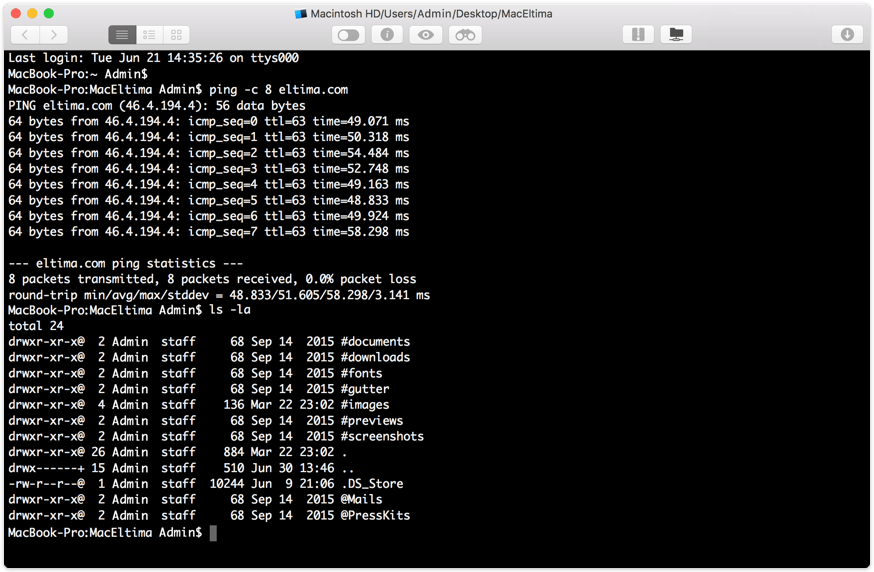Program Commands For Mac Terminal
Terminal is a Mac command line interface. There are several advantages to using Terminal to accomplish some tasks — it’s usually quicker, for example. In order to use it, however, you’ll need to get to grips with its basic commands and functions. If you administer a number of Macs, running common tasks through the command line can reduce your maintenance workload. Using a combination of system commands and open-source repositories, you can update both macOS software and Mac App Store software using Terminal. Terminal is a command prompt program that comes on every Mac computer and allows users to input detailed commands to customize the way the operating system behaves. With the right commands, you can customize your computer in more ways than is possible using the regular System Preferences menu. Terminal is Mac OS X way into the command line world. It is designed for you to typing in specific commands that you would not be able to do otherwise. This is great for customizing your Mac and unveiling hidden features.
- Program Commands For Mac Terminal Commands
- Program Commands For Mac Terminal Password
- Program Commands For Mac Terminal Tricks
If you administer a number of Macs, running common tasks through the command line can reduce your maintenance workload. Using a combination of system commands and open-source repositories, you can update both macOS software and Mac App Store software using Terminal.
Update macOS Software Using Terminal
You can update built-in macOS software using the softwareupdate command in Terminal.
1. Open Terminal (Application/Utilities/Terminal.app).
2. Type the following command and press “Enter:”
This will list all the macOS software updates that are currently available for your system.
3. Wait for a moment while it searches the macOS servers for updates.
4. If updates are available, softwareupdate will tell you which updates are available. If no updates are available, you’ll be returned to the command prompt.
5. To install all available updates, type the following command and press “Enter:”
Is there an excel program for imac. How can the answer be improved?
6. Type your password when prompted and press “Enter.”
7. The update process will now run, displaying each program’s progress as it is updated.

8. When the update process is finished, you’ll be returned to the command prompt.
Softwareupdate Flags
- The
--verboseflag is optional, but it will give live status reports as updates are installed. If you have a lot of updates to process, this flag will keep you abreast of the current status. - The
-iflag stands for “install” and will begin the installation process for selected apps - The
-aflag stands for “all.” This will install all available updates. - The
-rflag stands for “recommended.” For example,softwareupdate -irwill install only “recommended” updates. - The
-hflag stands for “help” and will reveal all available commands. - To install just one update, use
For example,
softwareupdate -i RemoteDesktopClient-3.9.2will install only the RemoteDesktopClient 3.9.2 update. - To ignore specific updates, use the
--ignoreflag. For example:will hide the 3.9.2 update of RemoteDesktopClient. You’ll be alerted when a new update is available.
Update Mac App Store Software Using Terminal
By default, macOS does not contain a command line utility for updating apps from the Mac App Store. However, you can install Dmitry Rodionov’s mas utility to add this functionality to your command line.
1. Open Terminal (Application/Utilities/Terminal.app).
2. If you don’t already have the Homebrew package manager installed, you’ll need to get it. Install Homebrew using the Terminal command below:
You can also follow our guide for getting set up with Homebrew.
Program Commands For Mac Terminal Commands
3. Use the following command to install mas-cli from the Homebrew database:
4. When the installation is complete and you have your command prompt back, you can type in mas to see a list of all available mas commands.
5. Type the following command to see a list of installed Mac App Store apps. There might be a few of them.
6. Type the following command to see all apps with updates available:
7. Type the following command to update all apps with updates available:
8. mas will run through the upgrade process for each app.
Program Commands For Mac Terminal Password
9. When the update process is complete, you’ll be returned to the command prompt.
Conclusion
Program Commands For Mac Terminal Tricks
If you need to update the built-in macOS software, or even macOS itself, you can use softwareupdate to complete that process from the command line. If you need to update apps from the App Store, you can install mas to get that done via Terminal.
